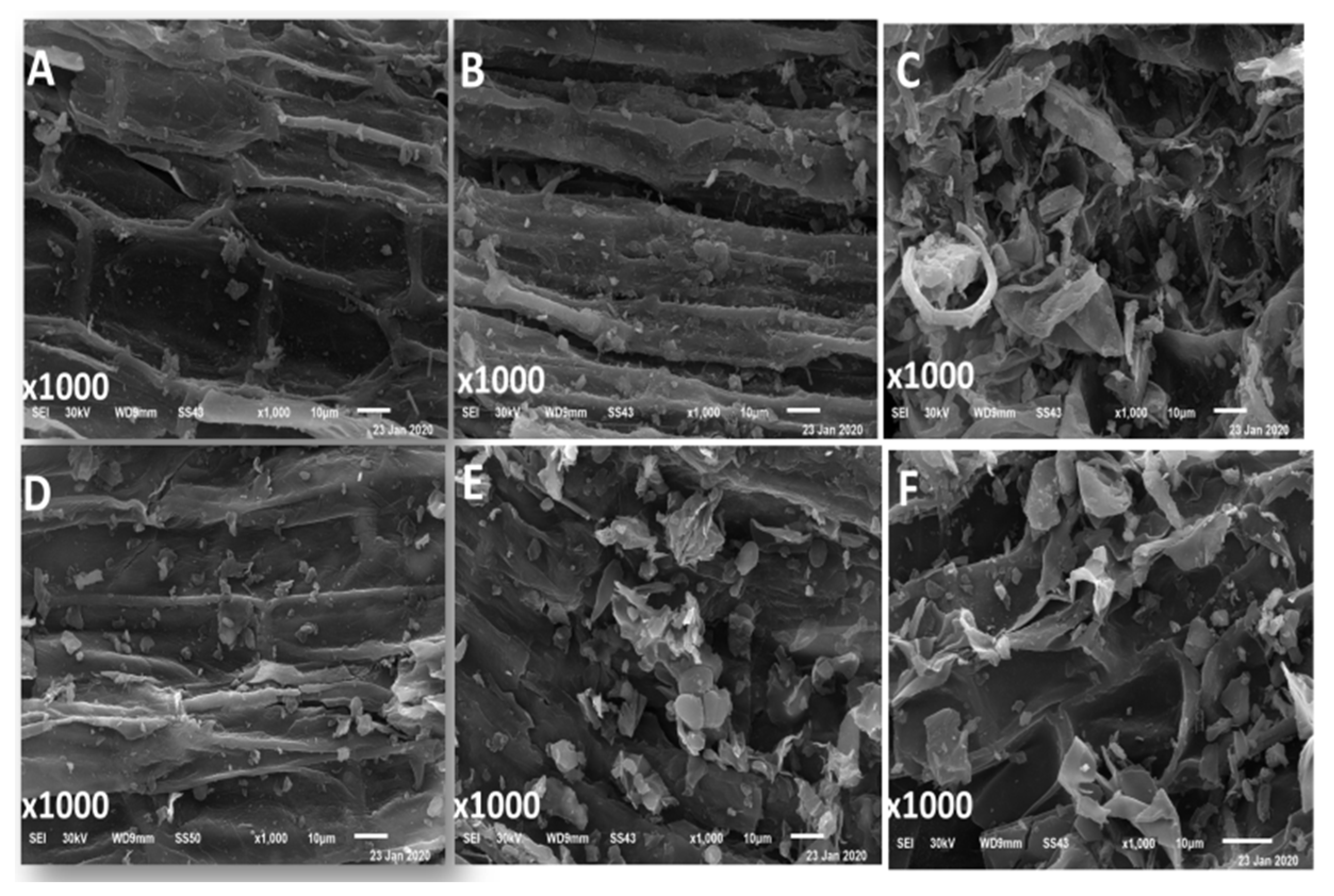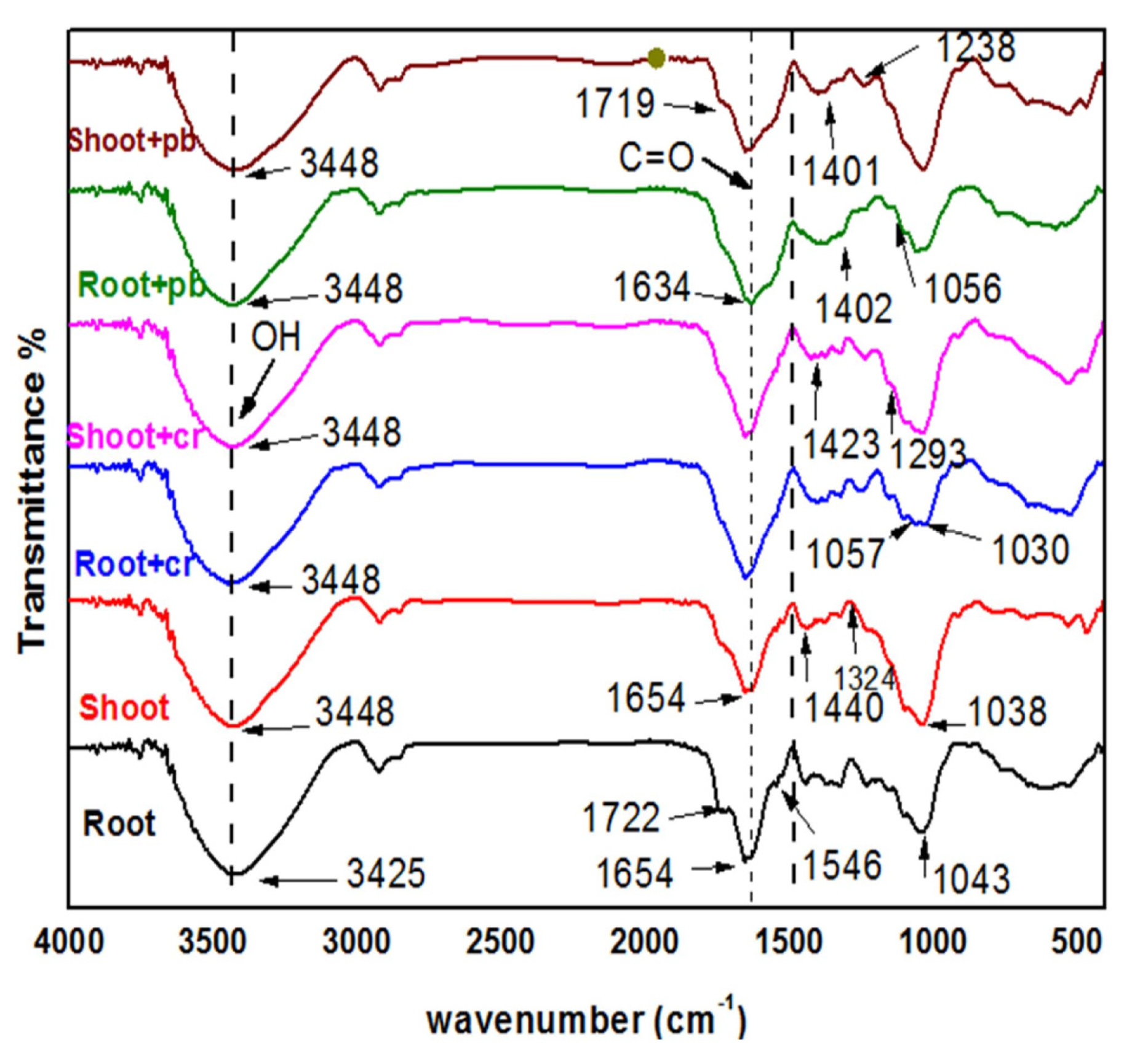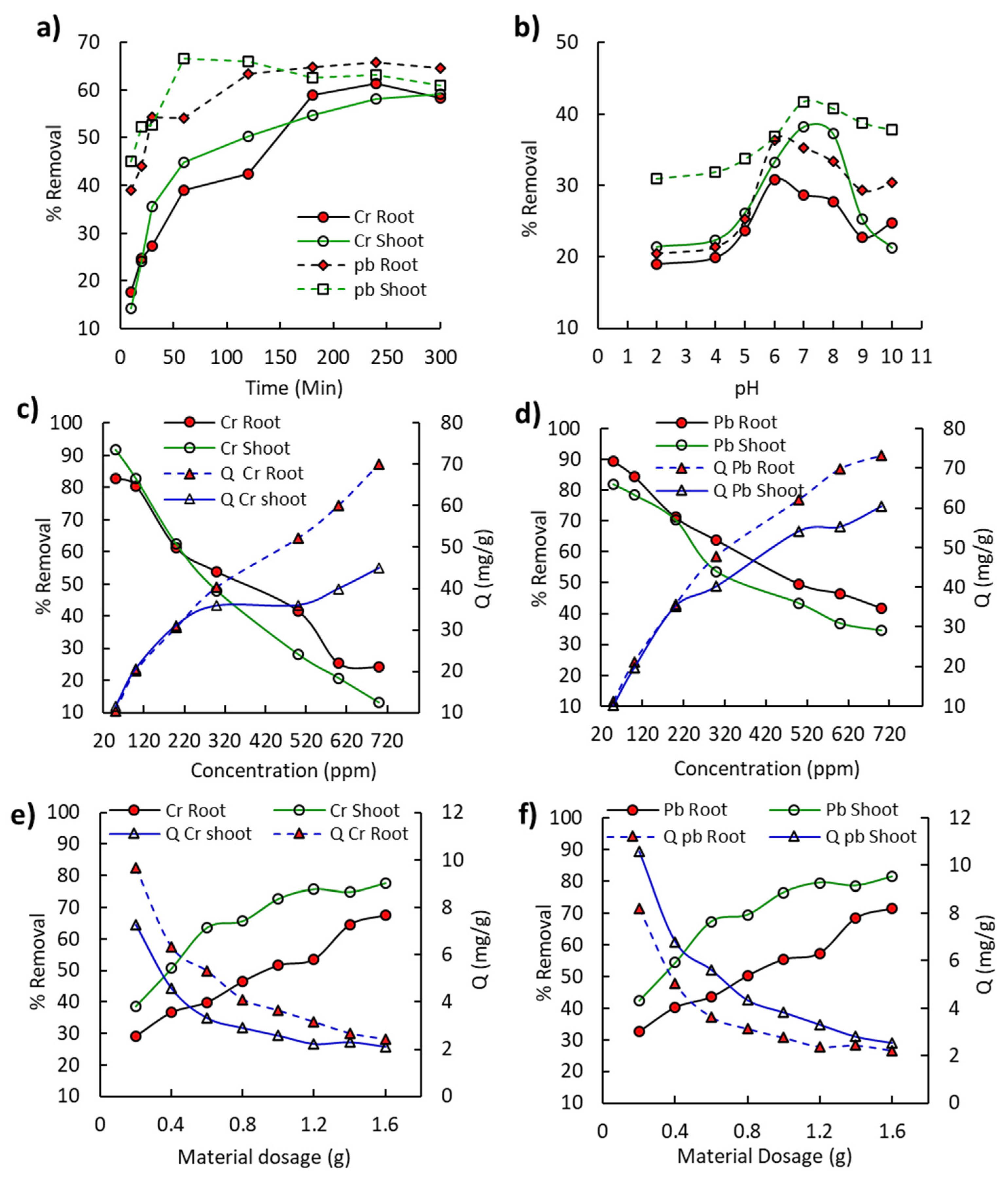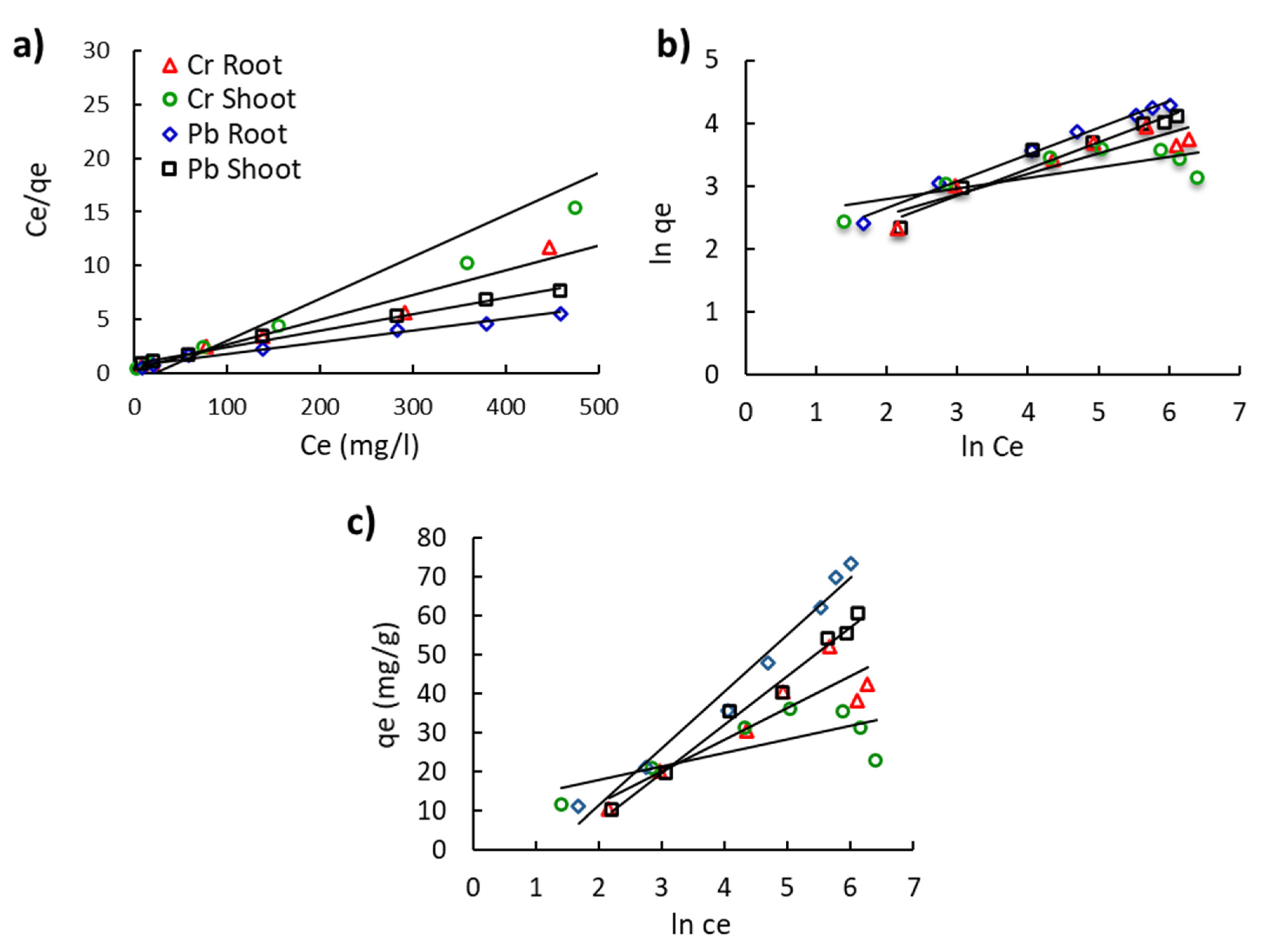Optimizing the Biosorption Behavior of Ludwigia stolonifera in the Removal of Lead and Chromium Metal Ions from Synthetic Wastewater
Abstract
1. Introduction
2. Materials and Methods
2.1. Sample Collection and Preparation of the Used Bio-Sorbent (L. stolonifera)
2.2. Preparation of Pb (II) and Cr (VI) Metal Ions Standard Solutions
2.3. The Used Bio-Sorbent (L. stolonifera) Characterization
2.4. Batch Bio-Sorption Studies
3. Results and Discussion
3.1. Bio-Sorbent Characterization
3.1.1. Scanning Electron Microscopy (SEM)
3.1.2. FTIR Analysis
3.2. Batch-mode Experiments
3.2.1. Effect of Bio-Sorption Contact Time
3.2.2. Effect of Solution pH
3.2.3. Effect of Initial Metal Ion Concentration
3.2.4. Effect of Bio-Sorbent Dosage
3.2.5. Equilibrium Modeling
3.2.6. Bio-Sorption Kinetic Models
| Metal Ion | Adsorbent Material | Adsorption Capacity (mg/g) | Reference |
|---|---|---|---|
| Pb2+ | Current study | 80.796 | |
| bael tree (BT) leaf powder | 4.065 | [43] | |
| Polyethyleneimine and carbon disulfide co-modified alkaline lignin | 79.9 | [44] | |
| Moringa Oleifera | 15.38 | [45] | |
| Cr6+ | Current study | 43.478 | |
| Soy Sauce Residue Biochar cr | 25.80 | [46] | |
| Low-Cost Adsorbent Prepared from Neem Leaves | 10 | [47] | |
| Durian Peel | 10.67 | [48] |
4. Conclusions
Author Contributions
Funding
Institutional Review Board Statement
Informed Consent Statement
Data Availability Statement
Acknowledgments
Conflicts of Interest
References
- Logam, P.; Kumbahan, A. Removal of Heavy Metals from Wastewater Using Date Palm as a Biosorbent. Comp. Rev. 2018, 47, 35–49. [Google Scholar]
- El Awady, F.R.; Abbas, M.A.; Abdelghany, A.M.; El-Amir, Y.A. Silver Modified Hydrophytes for Heavy Metal Removal from Different Water Resources. Biointerface Res. Appl. Chem. 2021, 11, 14555–14563. [Google Scholar]
- Elmorsi, R.R.; El-Wakeel, S.T.; El-Dein, W.A.S.; Lotfy, H.R.; Rashwan, W.E.; Nagah, M.; Shaaban, S.A.; Ahmed, S.A.S.; El-Sherif, I.Y.; Abou-El-Sherbini, K.S. Adsorption of Methylene Blue and Pb2+ by using acid-activated Posidonia oceanica waste. Sci. Rep. 2019, 9, 3356. [Google Scholar] [CrossRef]
- Baby, R.; Saifullah, B.; Hussein, M.Z. Palm Kernel Shell as an effective adsorbent for the treatment of heavy metal contaminated water. Sci. Rep. 2019, 9, 18955. [Google Scholar] [CrossRef]
- Kulkarni, P.S.; Watwe, V.S.; Hipparge, A.J.; Sayyad, S.I.; Sonawane, R.A.; Kulkarni, S.D. Valorization of Uncharred Dry Leaves of Ficus benjamina towards Cr (VI) removal from Water: Efficacy Influencing Factors and mechanism. Sci. Rep. 2019, 9, 19385. [Google Scholar] [CrossRef]
- Liu, H.; Zhang, F.; Peng, Z. Adsorption mechanism of Cr(VI) onto GO/PAMAMs composites. Sci. Rep. 2019, 9, 3663. [Google Scholar] [CrossRef]
- Mohamed, M.; Osman, M.; Potter, T.; Levin, R. Lead and cadmium in Nile River water and finished drinking water in Greater Cairo, Egypt. Environ. Int. 1998, 24, 767–772. [Google Scholar] [CrossRef]
- Mandour, R.A.; Ghanem, A.-A.; El-Azab, S.M. Correlation between lead levels in drinking water and mothers’ breast milk: Dakahlia, Egypt. Environ. Geochem. Heal. 2012, 35, 251–256. [Google Scholar] [CrossRef]
- Banks, E.C.; Ferretti, L.E.; Shucard, D.W. Effects of low level lead exposure on cognitive function in children: A review of behavioral, neuropsychological and biological evidence. NeuroToxicology 1997, 18, 237–281. [Google Scholar] [PubMed]
- Vaziri, N.D.; Gonick, H.C. Cardiovascular effects of lead exposure. Indian J. Med. Res. 2008, 128, 426–435. [Google Scholar] [PubMed]
- Wan, I.A.; Ara, A.; Usman, J.A. Lead Toxicity: A Review. Interdiscip. Toxicol. 2015, 8, 55–64. [Google Scholar] [CrossRef] [PubMed]
- Charkiewicz, A.E.; Backstrand, J.R. Lead Toxicity and Pollution in Poland. Int. J. Environ. Res. Public Health 2020, 17, 4385. [Google Scholar] [CrossRef]
- Thamer, B.M.; Aldalbahi, A.; Moydeen, A.M.; Al-Enizi, A.M.; El-Hamshary, H.; El-Newehy, M.H. Fabrication of functionalized electrospun carbon nanofibers for enhancing lead-ion adsorption from aqueous solutions. Sci. Rep. 2019, 9, 19467. [Google Scholar] [CrossRef] [PubMed]
- Burakov, A.E.; Galunin, E.V.; Burakova, I.V.; Kucherova, A.E.; Agarwal, S.; Tkachev, A.G.; Gupta, V.K. Adsorption of Heavy Metals on Conventional and Nanostructured Materials for Wastewater Treatment Purposes: A Review. Ecotoxicol. Environ. Saf. 2018, 148, 702–712. [Google Scholar] [CrossRef]
- Usman, K.; Al-Ghouti, M.A.; Abu-Dieyeh, M.H. The assessment of cadmium, chromium, copper, and nickel tolerance and bioaccumulation by shrub plant Tetraena qataranse. Sci. Rep. 2019, 9, 5658. [Google Scholar] [CrossRef] [PubMed]
- Santhosh, C.; Nivetha, R.; Kollu, P.; Srivastava, V.; Sillanpää, M.; Grace, A.N.; Bhatnagar, A. Removal of cationic and anionic heavy metals from water by 1D and 2D-carbon structures decorated with magnetic nanoparticles. Sci. Rep. 2017, 7, 14107. [Google Scholar] [CrossRef]
- Gholamreza, M.; Behnam, B. Biosorption of Chromium (VI) from Industrial Wastewater onto Pistachio Hull Waste Biomass. Chem. Eng. J. 2010, 162, 893–900. [Google Scholar]
- Fiol, N.; Escudero, C.; Villaescusa, I. Chromium sorption and Cr(VI) reduction to Cr(III) by grape stalks and yohimbe bark. Bioresour. Technol. 2008, 99, 5030–5036. [Google Scholar] [CrossRef]
- Nnaji, C.C.; Ebeagwu, C.J.; Ugwu, E.I. Physicochemical Conditions for Adsorption of Lead from Water by Rice Husk Ash. BioResources 2016, 12, 799–818. [Google Scholar] [CrossRef]
- Zahran, M.A.; Wills, A.J. The Vegetation of Egypt; Chapman Hall: London, UK, 1992. [Google Scholar]
- Pradhan, N.K.; Ghosal, S.C.I.; Jussiaea Repens, L. Is a Nontoxic Antigonadal Herb- a Dose Dependent Study on Male Rates. Int. J. Pharm. Bio Sci. 2013, 4, 131–143. [Google Scholar]
- Zhang, M.; Yin, Q.; Ji, X.; Wang, F.; Gao, X.; Zhao, M. High and fast adsorption of Cd(II) and Pb(II) ions from aqueous solutions by a waste biomass based hydrogel. Sci. Rep. 2020, 10, 3285. [Google Scholar] [CrossRef]
- Tackholm, V. Students’ Flora of Egypt, 2nd ed.; Cairo University Press: Cairo, Egypt, 1974. [Google Scholar]
- Boulos, L. Flora of Egypt; Al Hadara Publishing: Cairo, Egypt, 2000; Volume 2. [Google Scholar]
- Kumar, P.S.; Ramalingam, S.; Senthamarai, C.; Niranjanaa, M.; Vijayalakshmi, P.; Sivanesan, S. Adsorption of dye from aqueous solution by cashew nut shell: Studies on equilibrium isotherm, kinetics and thermodynamics of interactions. Desalination 2010, 261, 52–60. [Google Scholar] [CrossRef]
- Torab-Mostaedi, M. Biosorption of Lanthanum and Cerium from Aqueous Solutions Using Tangerine (Citrus Reticulata) Peel: Equilibrium, Kinetic and Thermodynamic Studies. Chem. Ind. Chem. Eng. Q/CICEQ 2013, 19, 79–88. [Google Scholar] [CrossRef]
- Mariño, M.; Da Silva, L.L.; Durán, N.; Tasic, L. Enhanced Materials from Nature: Nanocellulose from Citrus Waste. Molecules 2015, 20, 5908–5923. [Google Scholar] [CrossRef] [PubMed]
- Saxena, A.; Bhardwaj, M.; Allen, T.; Kumar, S.; Sahney, R. Adsorption of heavy metals from wastewater using agricultural–industrial wastes as biosorbents. Water Sci. 2017, 31, 189–197. [Google Scholar] [CrossRef]
- Sain, M.; Panthapulakkal, S. Bioprocess preparation of wheat straw fibers and their characterization. Ind. Crop. Prod. 2006, 23, 1–8. [Google Scholar] [CrossRef]
- Manzoor, K.; Ahmad, M.; Ahmad, S.I. Removal of Pb(ii) and Cd(ii) from Wastewater Using Arginine Cross-Linked Chitosan–carboxymethyl Cellulose Beads as Green Adsorbent. RSC Adv. 2019, 9, 7890–7902. [Google Scholar] [CrossRef]
- Abdić, Š.; Memić, M.; Šabanović, E.; Sulejmanović, J.; Begić, S. Adsorptive removal of eight heavy metals from aqueous solution by unmodified and modified agricultural waste: Tangerine peel. Int. J. Environ. Sci. Technol. 2018, 15, 2511–2518. [Google Scholar] [CrossRef]
- Al-Ghouti, M.A.; Da’Ana, D.; Abu-Dieyeh, M.; Khraisheh, M. Adsorptive removal of mercury from water by adsorbents derived from date pits. Sci. Rep. 2019, 9, 15327. [Google Scholar] [CrossRef] [PubMed]
- Morosanu, I.; Teodosiu, C.; Paduraru, C.; Ibanescu, D.; Tofan, L. Biosorption of lead ions from aqueous effluents by rapeseed biomass. New Biotechnol. 2017, 39, 110–124. [Google Scholar] [CrossRef]
- Semerjian, L. Removal of heavy metals (Cu, Pb) from aqueous solutions using pine (Pinus halepensis) sawdust: Equilibrium, kinetic, and thermodynamic studies. Environ. Technol. Innov. 2018, 12, 91–103. [Google Scholar] [CrossRef]
- Samra, S. Biosorption of Pb2+ from Natural Water Using Date Pits: A Green Chemistry Approach. Mod. Chem. Appl. 2014, 2, 1000131. [Google Scholar] [CrossRef]
- Ahmad, A.; Rafatullah, M.; Sulaiman, O.; Ibrahim, M.; Hashim, R. Scavenging behaviour of meranti sawdust in the removal of methylene blue from aqueous solution. J. Hazard. Mater. 2009, 170, 357–365. [Google Scholar] [CrossRef] [PubMed]
- Chaudhry, S.A.; Zaidi, Z.; Siddiqui, S.I. Isotherm, kinetic and thermodynamics of arsenic adsorption onto Iron-Zirconium Binary Oxide-Coated Sand (IZBOCS): Modelling and process optimization. J. Mol. Liq. 2017, 229, 230–240. [Google Scholar] [CrossRef]
- Gupta, V.K.; Ali, I.; Saleh, T.; Nayak, A.; Agarwal, S. Chemical treatment technologies for waste-water recycling—an overview. RSC Adv. 2012, 2, 6380–6388. [Google Scholar] [CrossRef]
- Chao, H.-P.; Chang, C.-C. Adsorption of copper(II), cadmium(II), nickel(II) and lead(II) from aqueous solution using biosorbents. Adsorption 2012, 18, 395–401. [Google Scholar] [CrossRef]
- Cheng, Q.; Fang, Z.; Yi, X.; An, X.; Tang, B.; Xu, Y. “Ex Situ” Concept for toughening the RTmable BMI matrix composites, part I: Improving the interlaminar fracture toughness. J. Appl. Polym. Sci. 2008, 109. [Google Scholar] [CrossRef]
- Attari, M.; Bukhari, S.S.; Kazemian, H.; Rohani, S. A low-cost adsorbent from coal fly ash for mercury removal from industrial wastewater. J. Environ. Chem. Eng. 2017, 5, 391–399. [Google Scholar] [CrossRef]
- Langergren, S.; Svenska, B.K. Zur Theorie Der Sogenannten Adsorption Geloester Stoffe. Veternskapsakad Handl. 1898, 24, 1–39. [Google Scholar]
- Senthil Kumar, P.; Gayathri, R. Adsorption of Pb2+ Ions from Aqueous Solutions onto Bael Tree Leaf Powder: Isotherms, Kinetics and Thermodynamics Study. J. Eng. Sci. Technol. 2009, 4, 381–399. [Google Scholar]
- Wang, Q.; Zheng, C.; Shen, Z.; Lu, Q.; He, C.; Zhang, T.C.; Liu, J. Polyethyleneimine and carbon disulfide co-modified alkaline lignin for removal of Pb2 + ions from water. Chem. Eng. J. 2019, 359, 265–274. [Google Scholar] [CrossRef]
- Adhiambo, O.R.; Lusweti, K.J.; Morang’A, G.Z. Biosorption of Pb2+ and Cr2+ Using Moringa Oleifera and Their Adsorption Isotherms. Sci. J. Anal. Chem. 2015, 3, 100. [Google Scholar] [CrossRef]
- Xu, X.; Zhou, C.; Zhang, S.; Cheng, Z.; Yang, Z.; Xian, J.; Yang, Y. Adsorption of Cr6+ and Pb2+ on Soy Sauce Residue Biochar from Aqueous Solution. BioResources 2019, 14, 4653–4669. [Google Scholar] [CrossRef]
- Babu, B.V. Adsorption of Cr (VI) by a Low-Cost Adsorbent Prepared from Neem Leaves. Int. J. Eng. Res. Technol. 2006, 1, 175–180. [Google Scholar]
- Saueprasearsit, P. Adsorption of Chromium (Cr+6) Using Durian Peel. 2011 Int. Conf. Biotechnol. Environ. Manag. IPCBEE 2011, 18, 33–38. [Google Scholar]
- EL-kady, M.F.; EL-aassar, M.R.; Ibrahim, M.S.; El batrawy, O.A.; Hassan, H.S.; Fakhry, H. Equilibrium and Kinetic Behaviors of Cationic Dye Decolorization Using Poly (AN-co-Py)/ZrO2 Novel Nanopolymeric Composites. Adv. Polym. Technol. 2018, 37, 740–752. [Google Scholar] [CrossRef]
- Ozacar, M.; Şengil, I. A kinetic study of metal complex dye sorption onto pine sawdust. Process. Biochem. 2005, 40, 565–572. [Google Scholar] [CrossRef]
- Crini, G.; Peindy, H.N.; Gimbert, F.; Capucine, R. Removal of C. I. Basic Green 4 (Malachite Green) from Aqueous Solutions by Adsorption Using Cyclodextrin-Based Adsorbent: Kinetic and Equilibrium Studies. Sep. Purif. Technol. 2007, 53, 97–110. [Google Scholar] [CrossRef]
- Poots, V.J.P.; McKay, G.; Healy, J.J. Removal of Basic Dye from Effluent Using Wood as an Adsorbent. J. Water Pollut. Control Fed. 1978, 50, 926–939. [Google Scholar]





| Bio-Sorption Models | Equation | Parameters |
|---|---|---|
| Langmuir | Ce/qe = 1/qmK + Ce/qm | qe is the bio-sorbate amount in the bio-sorbent at equilibrium (mg/g), qm is the maximum monolayer coverage capacities (mg/g), Kl is the Langmuir constant (L/mg), and Ce is the equilibrium concentration (mg/L). |
| Freundlich | ln qe = ln KF + 1/nf ln ce | qe is the of bio-sorbed ions amount at equilibrium (mg/g); Ce is the bio-sorbate equilibrium ions concentration (mg/L); KF and nf are Freundlich constants related to the bio-sorption capacity and bio-sorption intensity, respectively |
| Temkin | q e = B ln KT + B ln Ce | KT is the Temkin constant refer to equilibrium maximum binding energy and B is the Temkin constant related to bio-sorption heat. |
| Isotherm Parameters | Cr6+ | Pb2+ | ||
|---|---|---|---|---|
| Root | Shoot | Root | Shoot | |
| Langmuir | ||||
| qm (mg g−1) calculated | 43.478 | 25.641 | 80.796 | 65.519 |
| KL (L mg−1) | 0.056 | 0.045 | 0.018 | 0.017 |
| R2 | 0.975 | 0.944 | 0.988 | 0.992 |
| Freundlich | ||||
| KF (mg1−1/n L1/n g−1) | 6.619 | 11.658 | 6.056 | 4.926 |
| nf | 3.074 | 5.913 | 2.352 | 2.369 |
| R2 | 0.852 | 0.979 | 0.990 | 0.952 |
| Temkin | ||||
| BT (L mg−1) | 8.210 | 3.483 | 14.590 | 12.507 |
| KT (KJ mol−1) | 0.566 | 23.169 | 0.298 | 0.239 |
| R2 | 0.831 | 0.531 | 0.976 | 0.989 |
| Bio-Sorption Kinetic Models | Equation | Parameters |
|---|---|---|
| Pseudo-First-Order | Ln (qe-qt) =ln qe- K1t | qt is the bio-sorbed metal ions amount at time t, qe, is the bio-sorbed metal ions amount at equilibrium (mg/g). k1 (min−1) is the first-order reaction rate constant |
| Pseudo-Second-Order | t/qt = (1/K2qe2) | qt is the bio-sorbed metal ions amount at time t qe, the bio-sorbed metal ions amount at equilibrium (mg/g), k2 is the second-order reaction rate equilibrium constant (g/mg min). |
| Elovich | qt = ὰ +ß ln t | ὰ is the initial sorption rate (mg/g min) and ß is the extent of surface coverage and activation energy for chemisorption (g/mg) |
| Intra-particle Diffusion | qt = kidt1/2+ I | kid is the intra-particle diffusion rate constant, and I give prediction about the boundary layer thickness |
| Kinetic Model | Cr6+ | Pb2+ | |||
|---|---|---|---|---|---|
| Root | Shoot | Root | Shoot | ||
| Pseudo-First-Order | qe (mg/g) Calculated | 12.541 | 7.478 | 3.712 | 2.335 |
| qe (mg/g) Experimental | 14.748 | 14.523 | 15.838 | 16.625 | |
| k1 (min−1) | 0.013 | 0.009 | 0.006 | 0.005 | |
| R2 | 0.938 | 0.830 | 0.693 | 0.193 | |
| Pseudo-Second-Order | qe (mg/g) Calculated | 16.944 | 16.313 | 16.807 | 15.625 |
| qe (mg/g) Experimental | 14.748 | 14.523 | 15.838 | 16.625 | |
| k2 (g/mg min) | 0.038 | 0.044 | 0.081 | 0.247 | |
| R2 | 0.990 | 0.999 | 0.991 | 0.998 | |
| Elovich | ß (g/mg) | 3.347 | 3.266 | 1.980 | 1.248 |
| ὰ (mg/g min) | 3.899 | 3.202 | 5.655 | 9.360 | |
| R2 | 0.977 | 0.971 | 0.928 | 0.657 | |
| Intra-particle Diffusion | kid, | 0.779 | 0.726 | 0.440 | 0.249 |
| I | 2.707 | 3.574 | 9.794 | 12.227 | |
| R2 | 0.971 | 0.938 | 0.825 | 0.477 | |
Publisher’s Note: MDPI stays neutral with regard to jurisdictional claims in published maps and institutional affiliations. |
© 2021 by the authors. Licensee MDPI, Basel, Switzerland. This article is an open access article distributed under the terms and conditions of the Creative Commons Attribution (CC BY) license (https://creativecommons.org/licenses/by/4.0/).
Share and Cite
El-Amier, Y.A.; Elsayed, A.; El-Esawi, M.A.; Noureldeen, A.; Darwish, H.; Fakhry, H. Optimizing the Biosorption Behavior of Ludwigia stolonifera in the Removal of Lead and Chromium Metal Ions from Synthetic Wastewater. Sustainability 2021, 13, 6390. https://doi.org/10.3390/su13116390
El-Amier YA, Elsayed A, El-Esawi MA, Noureldeen A, Darwish H, Fakhry H. Optimizing the Biosorption Behavior of Ludwigia stolonifera in the Removal of Lead and Chromium Metal Ions from Synthetic Wastewater. Sustainability. 2021; 13(11):6390. https://doi.org/10.3390/su13116390
Chicago/Turabian StyleEl-Amier, Yasser A., Ashraf Elsayed, Mohamed A. El-Esawi, Ahmed Noureldeen, Hadeer Darwish, and Hala Fakhry. 2021. "Optimizing the Biosorption Behavior of Ludwigia stolonifera in the Removal of Lead and Chromium Metal Ions from Synthetic Wastewater" Sustainability 13, no. 11: 6390. https://doi.org/10.3390/su13116390
APA StyleEl-Amier, Y. A., Elsayed, A., El-Esawi, M. A., Noureldeen, A., Darwish, H., & Fakhry, H. (2021). Optimizing the Biosorption Behavior of Ludwigia stolonifera in the Removal of Lead and Chromium Metal Ions from Synthetic Wastewater. Sustainability, 13(11), 6390. https://doi.org/10.3390/su13116390









